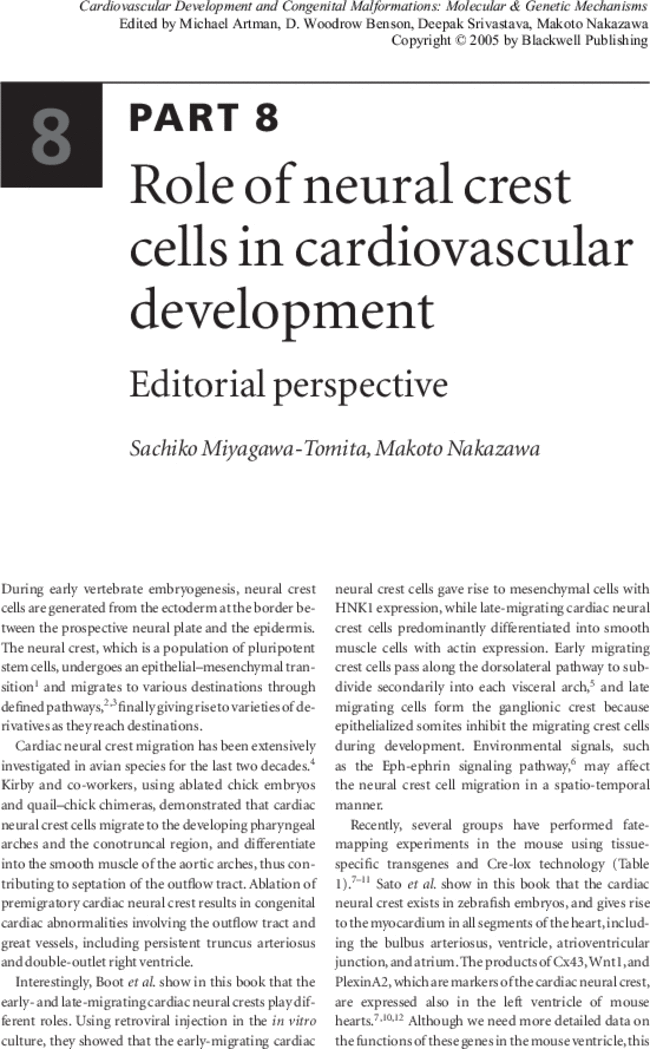Role of Neural Crest Cells in Cardiovascular Development
Sachiko Miyagawa-Tomita,
Makoto Nakazawa,
Sachiko Miyagawa-Tomita
Search for more papers by this authorMakoto Nakazawa
Search for more papers by this authorSachiko Miyagawa-Tomita,
Makoto Nakazawa,
Sachiko Miyagawa-Tomita
Search for more papers by this authorMakoto Nakazawa
Search for more papers by this authorBook Editor(s):Michael Artman MD, D. Woodrow Benson MD, PhD,
Deepak Srivastava MD,
Makoto Nakazawa MD,
D. Woodrow Benson MD, PhD
Professor of Pediatrics, Director, Cardiovascular Genetics, Division of Cardiology, Cincinnati Children's Hospital Medical Center
Search for more papers by this authorDeepak Srivastava MD
Pogue Distinguished Chair in Research on Cardiac Birth Defects, Joel B. Steinberg, M.D. Chair in Pediatrics Professor, Departments of Pediatrics and Molecular Biology, University of Texas, Southwestern Medical Center at Dallas
Search for more papers by this authorMakoto Nakazawa MD
Professor and Head, Pediatric Cardiology, The Heart Institute of Japan, Tokyo Women's Medical University
Search for more papers by this authorFirst published: 01 January 2005

References
- Bronner-Fraser M, Fraser SE. Cell lineage analysis reveals multipotency of some avian neural crest cells. Nature 1988; 335: 161–4.
- Le Douarin NM. The Neural Crest. London: Cambridge University Press, 1982.
- Hall BK, Horstadius S. The Neural Crest. London: Oxford University Press, 1988.
- Kirby ML, Gale TF, Stewart DE. Neural crest cells contribute to normal aorticopulmonary septation. Science 1983; 220: 1059–61.
- Shigetani Y, Aizawa S, Kuratani S. Overlapping origins of pharyngeal arch crest cells on the postotic hindbrain. Dev Growth Diff 1995; 37: 733–46.
- Smith A, Robinson V, Patel K, Wilkinson DG. The EphA4 and EphB1 receptor tyrosine kinases and ephrin-B2 ligand regulate targeted migration of branchial neural crest cells. Curr Biol 1997; 7: 561–70.
-
Lo, C.W. et al.
Cx43 gap junction gene expression and gap junctional communication in mouse neural crest cells.
Dev Genet
1997;
20: 119–32.
10.1002/(SICI)1520-6408(1997)20:2<119::AID-DVG5>3.0.CO;2-A CAS PubMed Web of Science® Google Scholar
- Waldo KL, Lo CW, Kirby ML. Connexin 43 expression reflects neural crest patterns during cardiovascular development. Dev Biol 1999; 208: 307–23.
- Yamauchi Y, et al. A novel transgenic technique that allows specific marking of the neural crest cell lineage in mice. Dev Biol 1999; 212: 191–203.
- Jiang X, Rowitch DH, Soriano P, McMahon AP, Sucov HM. Fate of the mammalian cardiac neural crest. Development 2000; 127: 1607–16.
-
Li J,
Chen F,
Epstein JA.
Neural crest expression of Cre re-combinase directed by the proximal Pax3 promoter in transgenic mice.
Genesis
2000;
26: 162–4.
10.1002/(SICI)1526-968X(200002)26:2<162::AID-GENE21>3.0.CO;2-R CAS PubMed Web of Science® Google Scholar
- Brown CB, et al. PlexinA2 and semaphorin signaling during cardiac neural crest development. Development 2001; 128: 3071–80.
- Farrell MJ, et al. FGF-8 in the ventral pharynx alters development of myocardial calcium transients after neural crest ablation. J Clin Invest 2001; 107: 1509–17.
- Kurihara Y, et al. Aortic arch malformations and ventricular septal defect in mice deficient in endothelin-1. J Clin Invest 1995; 96: 293–300.
- Yanagisawa H, et al. Dual genetic pathways of endothelin-mediated intercellular signaling revealed by targeted disruption of endothelin converting enzyme-1 gene. Development 1998; 125: 825–36.
- Clouthier DE, et al. Cranial and cardiac neural crest defects in endothelin-A receptor-deficient mice. Development 1998; 125: 813–24.
- Mendelsohn C, et al. Function of the retinoic acid receptors (RARs) during development (II). Multiple abnormalities at various stages of organogenesis in RAR double mutants. Development 1994; 120: 2749–71.
- Lee RY, Luo J, Evans RM, Giguere V, Sucov HM. Compartment-selective sensitivity of cardiovascular morphogenesis to combinations of retinoic acid receptor gene mutations. Circ Res 1997; 80: 757–64.
- Schilham MW, et al. Defects in cardiac outflow tract formation and pro-B-lymphocyte expansion in mice lacking Sox-4. Nature 1996; 380: 711–14.
- Ya J, et al. Sox4-deficiency syndrome in mice is an animal model for common trunk. Circ Res 1998; 83: 986–94.
- Winnier GE, et al. Roles for the winged helix transcription factors MF1 and MFH1 in cardiovascular development revealed by nonallelic noncomplementation of null alleles. Dev Biol 1999; 213: 418–31.
- Kume T, Jiang H, Topczewska JM, Hogan BL. The murine winged helix transcription factors, Foxc1 and Foxc2, are both required for cardiovascular development and somi-togenesis. Genes Dev 2001; 15: 2470–82.
- Iida K, et al. Essential roles of the winged helix transcription factor MFH-1 in aortic arch patterning and skeletogenesis. Development 1997; 124: 4627–38.
- Feiner L, et al. Targeted disruption of semaphorin 3C leads to persistent truncus arteriosus and aortic arch interruption. Development 2001; 128: 3061–70.
- Kawasaki T, et al. A requirement for neuropilin-1 in embryonic vessel formation. Development 1999; 126, 4895–902.
- Jerome LA, Papaioannou VE. DiGeorge syndrome phenotype in mice mutant for the T-box gene, Tbx1. Nat Genet 2001; 27: 286–91.
- Lindsay EA, et al. Tbx1 haploinsufficieny in the DiGeorge syndrome region causes aortic arch defects in mice. Nature 2001; 410: 97–101.
- Merscher S, et al. TBX1 is responsible for cardiovascular defects in velocardiofacial/DiGeorge syndrome. Cell 2001; 104: 619–29.
- Epstein JA, et al. Migration of cardiac neural crest cells in Splotch embryos. Development 2000; 127, 1869–78.



